Is Latvia Latveria?
(Marie-Mail entry #37)
RIGA, LATVIA
JUNE 4
I tiptoed out of the Donkey's Stable at six a.m. and caught a double-decker Eurolines bus to Latvia. Less than five hours later, I was in Riga.
 bus to Riga
bus to Riga
Riga is a thriving metropolis of 800,000 people as compared to Tallinn's 400,000. I stumbled out of the bus station, crossed the road via a pedestrian underpass, and followed busy Caka Street past McDonald's and Bennetton to my chosen hotel.
Hotel Viktorija, according to "Riga In Your Pocket," is housed in a "beautifully restored art nouveau building." It's a large, modern hotel with suites and $40 singles. But I wasn't interested in a $40 room. I had reserved a rundown room in the old wing for $11 a night. Toilets and showers were down the hall, and the rooms themselves looked ancient, but the Viktorija had treated my internet booking with the respect and seriousness usually reserved for high-class clients.
The room was nothing worth hanging around in, so I dropped of my pack and hurried to a dirt-cheap vegetarian buffet, located in the shadow of Old Riga's towering Dome Cathedral.
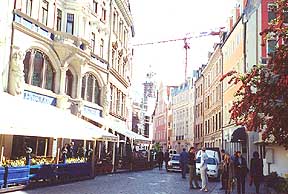 old Riga
old Riga
Old Riga, like Tallinn's Old Town is the city within the city. Once bounded by city walls, today it is separated from cosmopolitan new Riga by a canal, a river, the railway, and a band of parks. Unlike Tallinn, however, Riga's old city is less quaint, less compact, and more of an active city patronized by locals and not just weekend warriors (and knights).
The sky was overcast -- it was likely to pour rain at any minute -- so I skipped my planned self-guided walking tour and hurried to the Museum of the Occupation of Latvia.
What a depressing education I got! The Latvians, along with the Estonians and Lithuanians, were dominated by Russians, Prussians, Poles, and Swedes until World War I. The three tiny countries achieved independence for a few decades, but then Stalin took over after his foolish, deadly 1939 deal with Hitler.
Within the year, the Soviets began the systematic purges. 35,000 Latvians alone were sent to Siberia for refusing to acknowledge Soviet rule.
And then the Germans came in 1941. What a relief, though the Balts. Of course time would tell that it was a case of "out of the frying pan and into the fire," and then back into the frying pan. A staggering number of Balts lost their lives to the Nazis; some even collaborated against Jewish friends and neighbors. And then Stalin was given Eastern Europe after World War II, and 175,000 more Latvians were killed or deported for such heinous crimes as "being Latvian." Plenty of others fled to the west of took to renegade forest living.
Meanwhile, over at Marvel Comics, Jack Kirby and Stan Lee created Dr. Doom, ruler of Latveria. In the thirteen years I worked for Marvel, the only thoughts I gave Dr. Doom were related to his current costume colors, his changeable status as friend or enemy to the Fantastic Four, and the location of the film for his trade paperback. I never considered the blatant symbolism of his iron mask (curtain), or of his beautiful Eastern European-ish country, shrouded in secrecy and ruled by an unpredictable dictator. (Comic books are not known for their subtlety.) Mind you, if Latvia really had been rules by Dr. Doom, they would've been better off. Stalin and Hitler wouldn't have stood a chance against Kirby technology and Doom, to my knowledge, never purged anyone save his own Doombots.
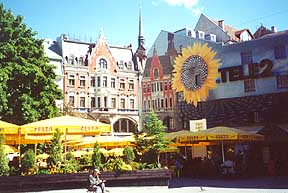 main square in old Riga
main square in old Riga
The high(low?)light of the museum was a life-sized Gulag barracks. Visitors could walk through it and imagine it filled with dozens of Latvian dissidents, all forced to use the same public oil drum as a toilet. Chinese toilets looked like the Grand Hyatt ladies' room in comparison.
I retired to Monte Kristo, an atmospheric coffee shop off a cobblestone lane. I bought a French press coffee, local Laima chocolate, and sat at a cherry-stained wooden table by a window. I could hear a host of beeping patrons keeping Finland's "Nokia" in business, while on the stereo Bob Dylan offered me shelter from the storm. I had been bombarded with a crash-course in Soviet history, and needed time to sort out my thoughts.
The USSR, it seemed, had continued to play "The Great Game," long after the rest of the world had ceased overt participation. The Vietnam-American War, perhaps, brought an end to declared spheres of influence in the west (today the U.S. extends influence via pop culture and financial aid). The Soviets dominated the Baltics, Central Asia, and Eastern Europe, (even invading Afghanistan) throughout the 80's. While Soviet rule brought infrastructure and literacy, it also brought death and fear to many.
But communism itself, I was convinced, was not the problem. It was just an idea -- a familiar-sounding idea that all people are created equal. What could possibly be wrong with that? The idea had liberated the Chinese from their emperor and given peasants basic human rights. Communism is not the opposite of democracy -- it is the opposite of capitalism (something practiced with great enthusiasm in both China and Vietnam).
No, the problem was in the execution, where power-mad leaders like Stalin decided that all men were created equal, except for themselves, who were somehow destined to be richer and more powerful than everyone else. And no system of checks and balances had been in place to kick Stalin out when he'd shown his true colors.
The end result, as far as the Baltics were concerned, was that they had been illegally occupied for fifty years while the world looked the other way due to Soviet military might.
I stopped by the posh Hotel de Rome on the way home, to visit the ladies' room. It was looked, requiring a keycard for access. This was often the case in this part of the world. Even McDonald's used a token system for bathroom admission, and I often found myself hovering outside, waiting for a customer to leave so I could grab the open door before it shut again.
SIGULDA
JUNE 5
Yesterday's drizzle was gone. It was a perfect day to see the picturesque town of Sigulda.
But first, I had to pull on my jeans and trek to the front desk for the shower room key. And then -- dripping wet -- I had to return it. But the water was hot and the pressure strong. That was more than I expected for $11 a night.
I stopped by "Cafe Osiris" for breakfast. The sun streamed through the broad picture window onto the green faux marble countertop, giving my scrambled eggs a healthy glow. Outside, well-dressed young executives, clad in black Versace and sunglasses, lined up at tram stops. Some carried small bunches of wildflowers, purchased from poor old women selling on street corners.
I left Osiris and walked to Hotel de Rome, the meeting point for the Sigulda tour I had booked through Latvia Tours.
The tour bus was full of older European tourists, and the common language was English. Two tour guides escorted us -- one of the English speakers and one for the German speakers. As luck would have it, even the German-speakers were fluent in English, and the second tour guide acted only as a backup English helper.
The guide pointed out various sights as we left the city. Riga itself was an unexpected mix of architectural styles -- here a baroque building, there an art nouveau hotel, there a hideous chunky cement block of housing.
"That hotel," said the guide, pointing, "is where the tourists used to have to stay. It was so the KGB could easily watch them."
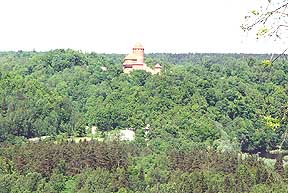 Turaida Castle
Turaida Castle
On we drove, fifty kilometers to Turaida Castle. The brochure had advertised it as "13th Century." In reality, the ruins are new -- all completely reconstructed based on ancient documents and diggings. But the grounds were serene, carefully landscaped, and topped off with a busker and his electric piano. The view from the tower was spectacular -- Sigulda is located in the wooded Gauja National Park.
We lost a confused older man with a video camera, so Guide #1 had to stay behind to find him. Guide #2 escorted us back to the bus, to travel to our next stop, Gutman's Cave.
The stream in the cave was reputed to have fountain of youth-esque powers. Everyone gamely stooped down and had a sip, but the sun is more powerful than any stream. The brown crinkly bits around my eyes that appeared some time between February and April did not vanish.
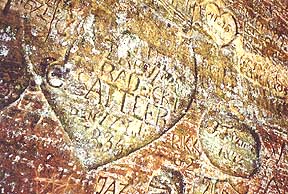 ancient grafitti in Gutman's Cave
ancient grafitti in Gutman's Cave
Guide #1 reappeared at Sigulda Castle, apologetic tourist in tow. The castle was authentic, but the few walls that remained were not safe to crawl around on.
The verdict on Sigulda, at the end of the day, was "lovely day trip but not a whole lot to actually see." I was pleased just to have ridden through the Latvian countryside.
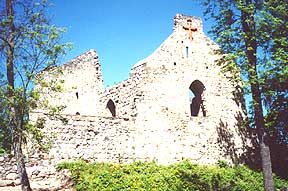 Sigulda Castle
Sigulda Castle
Back in Riga, I drank two cups of cinnamon coffee at Monte Kristo, and ate more Laima chocolate. I stumbled back to Hotel Viktorija, jazzed on caffeine, sugar, and the constant daylight of White Nights.
JUNE 6
I had to force myself to the front desk for the shower key.
"I could just skip today," I thought. And then I remembered that I had no idea what kind of place I'd be staying in later. The shower won.
I managed to catch a tram to the bus station, only to unsuccessfully attempt to board a nice, luxury bus.
"No," said the conductor. He waved me over to a ratty old Soviet bus, its windshield decked out in plastic roses.
Thirty others got on the bus with me. The driver revved the engine, and we were off to Lithuania.
NEXT: What do Stalin, Lenin, and Frank Zappa have in common?